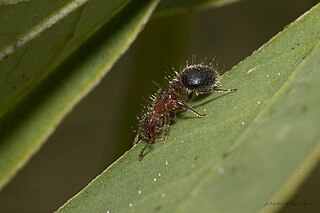
Loweriella boltoni is a species of ant and is the only known species of genus Loweriella. The species is only known from workers collected in the rainforest in Sarawak, Malaysia.
Barry Bolton is an English myrmecologist, an expert on the classification, systematics, and taxonomy of ants, who long worked at the Natural History Museum, London. He is known especially for monographs on African and Asian ants, and for encyclopaedic global works, including the Identification Guide to Ant Genera (1994), A New General Catalogue of Ants of the World, Synopsis and Classification of Formicidae (2003), and Bolton's Catalogue of Ants of the World: 1758-2005 (2007). Now retired, Bolton is a Fellow of the Royal Entomological Society and Myrmecologist, Biodiversity Division, Department of Entomology, Natural History Museum, London.

Crematogastrini is a tribe of myrmicine ants with 64 genera and 8 fossil genera.

Anochetus boltoni is a species of ant in the genus Anochetus. It was discovered in 2003 by B. L. Fisher in Madagascar and described by Fisher, B. L. & Smith, M. A. in 2008.

Asphinctopone differens is a species of ant in the subfamily Ponerinae.

Anomalomyrma is an Asian genus of ants in the subfamily Leptanillinae. The genus was originally described in 1990 with the type species Anomalomyrma taylori, based on a single dealate queen from Borneo. Workers were unknown until 2011, when two new species were described from Peninsular Malaysia and the Philippines.

Cryptomyrmex is a genus of ant in the subfamily Myrmicinae. The genus is known from Brazil and Paraguay.
Meranoplus parviumgulatus is a species of ant in the genus Meranoplus. It is known from New Guinea and Papua New Guinea.

Dicroaspis is an African genus of ants in the subfamily Myrmicinae.

Chimaeridris is a small genus of ants in the subfamily Myrmicinae. The genus contains two species known from tropical Asia. Their unique hook-shaped mandibles and similar appearance to Pheidole minor workers raises the possibility that the genus is a slave-maker of Pheidole ants or a specialized predator.

Meranoplus is an Old World genus of ants in the subfamily Myrmicinae. With over 80 valid species, it is predicted that over half of the Meranoplus diversity remains undescribed, most of these from Australia.
Daceton boltoni is a Neotropical species of arboreal ants in the subfamily Myrmicinae. The species occurs in Peru and Brazil and is similar to its sister species, D. armigerum.
Meranoplus cryptomys is a Malagasy species of ant in the genus Meranoplus.

Meranoplus bicolor, is a species of ant of the subfamily Myrmicinae. It is found in many Asian countries, where its habitats range from open grasslands to open-canopy forests. They nest in soil, usually at the base of plants. The nest opening is a simple hole, but it can sometimes have multiple openings. Workers forage on the ground as well as on plants, where they exploit extrafloral nectaries and tend to aphids.
Meranoplus levis is a species of ant of the subfamily Myrmicinae. It is found in Sri Lanka, and India.
Meranoplus loebli is a species of ant of the subfamily Myrmicinae. It is found in Sri Lanka.
Monomorium boltoni is a species of insects of the family Formicidae, the ants. The species is endemic to Cape Verde, where it is restricted to the island of São Nicolau. The species was first described in 1987.









